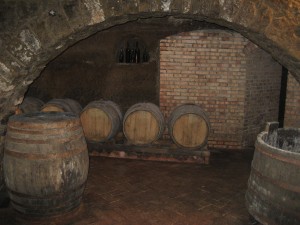I’ve been answering a lot of questions about whisky lately, from friends who want recommendations to bartenders that want to know better ways to promote their whisky selection. I’m going to take a break from whisky for a bit to write that wonderful annual essay, “How I Spent My Summer,” in this case known as “Here is Why I Haven’t Written in a While and While I’ll Now Write About Wine Instead of Whisky.”
I spent the latter weeks of the summer far away from the Internet, both in the physical and historical sense when I joined an archaeology project in Southern Italy. For several weeks, I was on a project excavating a Roman site near the town of Rionero in the Basilicata region. We excavated everything from tombs that were nearly 2,000-years-old to the remains of a potential villa. Among the latter we found many pottery pieces, some of which may have once upon a time held the very wine the region is known for: Aglianico.
The Aglianico grape produces wines with overtones of dark fruit, sharp spices and rich chocolates. The vines have grown strong and healthily in the region thanks to soil that was made rich by the eruption of the Vulture volcano some 40,000 years ago. The ancients found the area perfect for vineyards, and even today, many families have their own small vineyards where the patriarchs produce house wines that are minimally aged and enthusiastically imbibed.
In the Middle Ages, the passion of Rionero’s residents for this wine was so great that they dug cellars out of the limestone beneath their homes, and often ran into their neighbors digging tunnels of their own. Every household had their own wine making and storage facility right at their feet…or at least a few feet beneath their feet. The town today sits upon miles of these artificial grottos. Lord forbid that any kind of earthquake hit the region. The entire town would sink about 30 feet if that happened.
Today, the award-winning Cantine del Notaio (http://www.cantinedelnotaio.it/) winery is headquartered above a series of grottos once used by Franciscan monks in the late Renaissance period. The winery is named after the notary who owned the buildings a couple of hundred years ago, and their wines reflect this history. The wines are named after such notary terms as La Firma (the signature at the end of a contract) or La Stipula (the stipulation of a contract).
A tour of Cantine del Notaio takes visitors through a subterranean maze of limestone grottos and where the French Oak barrels used to mature the wine are stored. The grottos are cool, moist and the ideal places to age wine at a constant temperature, especially during the hot, dry summer season. The grottos sit just a few feet above the water table, so there is the constant drip of moisture from the walls, and if you listen carefully, the quiet gurgle of water from the cavities beneath the carved out caves. Like in all of these wine grottos, Cantine del Notaio’s storage facilities include a cross-topped shrine to bring God’s blessings from above to the wine workings below.
The winery produces some 200,000 bottles a year. My personal favorites are the L’Autentica moscato and the Il Rogito. The L’Autentica moscato brings delightful dances of honey, apricot, and lemon to the nose. The palate is thick and syrupy with flavors of peach compote and watermelon. Overall, the sweet white wine evokes the thrill you have smelling an amazing perfume on a woman Saturday night hoping you can still bask in its lingering effects Sunday morning.
Il Rogito is a still rose, with an amazing ruby red body. You almost get as much joy looking at its color as you do drinking it. The nose is a rich floral bouquet of high priced flowers, the palate fruity, and the finish like a cherry turnover. This is the kind of wine you would want to raise in toast at a fairytale wedding. It’s simply fantastic.
The thing I really like about Cantine del Notaio, and wine making in the Rionero region in general, is you don’t feel like you’re drinking something that is, ultimately, a commercial product. Many wine regions in the world are wonderful and the wineries have rich family histories. Yet, there is a marriage between the art and the commerce of winemaking. In Rionero, you feel the people are making wine because they need something good to drink with Sunday lunch, and if outsiders want to buy it, well…that’s nice, too.


Would you like to receive press releases from Morrison Bowmore Distillers about our brands? Please get in touch if you are interested.